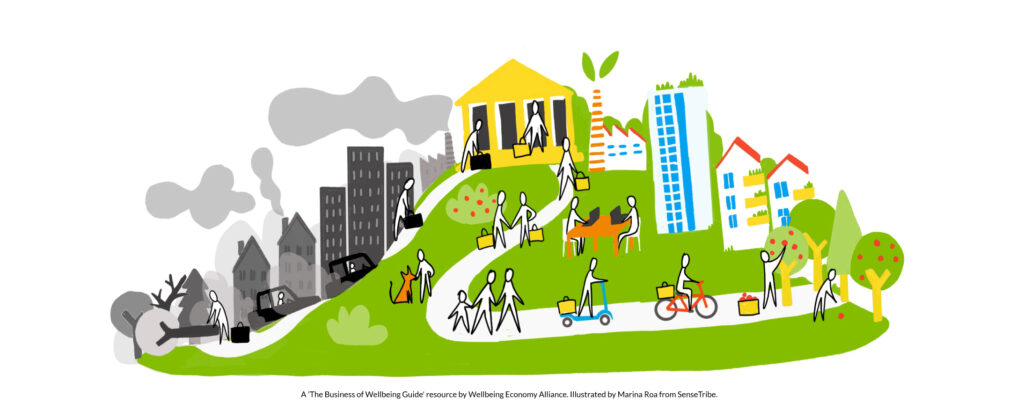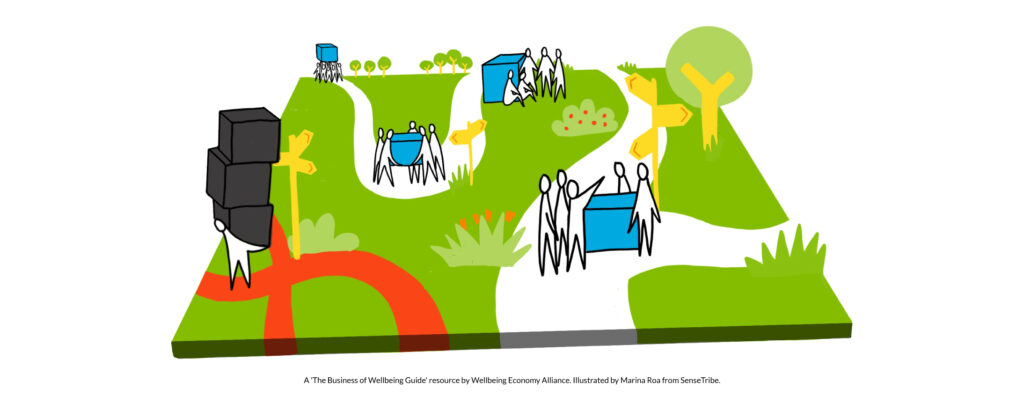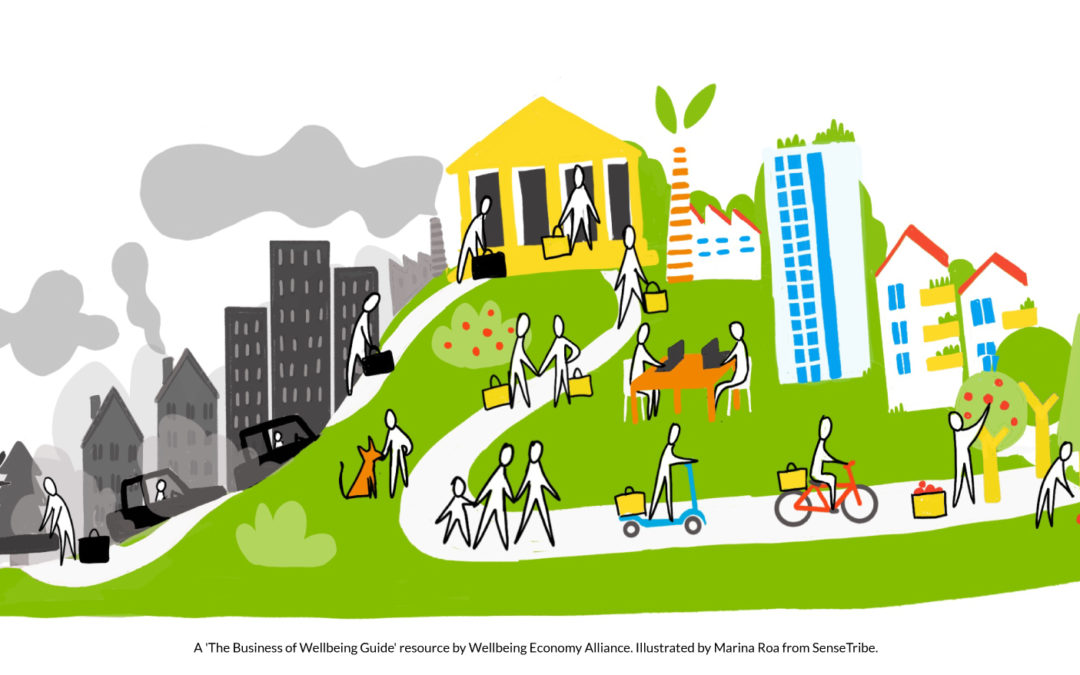The result of our collaboration with the Wellbeing Alliance to encourage alternative management models is now available
One of our main goals as a company is to help develop and encourage other ways to run businesses, which reflect or incentivize alternative business cultures based on new conceptions of the relationship between people and the services or products they deliver as well as the relationships between the companies and all their stakeholders. So when we were asked by the people at the Wellbeing Alliance to facilitate the development of a guide on alternatives to traditional business, we found this project to be very much aligned with our mission.
In this context started by developing a collaborative process aiming to include many stakeholders including a steering group of business and wellbeing economy experts. The purpose was to determine the scope, target audience, structure and content of the guide. Based on the input gathered we defined 7 key business dimensions, developed a self-assessment tool and a solutions framework, and carried out interviews with representatives of the organisations whose case studies are featured in the document. The idea behind the guide is to inspire decision makers of mid-sized organizations to explore the Wellbeing Economy space. This innovative document is a constant work in progress and will be regularly updated based on suggestions, recommendations, examples etc.
The Context
The guide begins with the observation that business today is at a crossroads between maintaining the traditional top-down structure and approach to labor, production and resource management on the one hand, and more humane and ecologically attentive approaches to business on the other hand.
The first risks leading to more burnouts, overworking and general misalignment of the companies’ priorities with those of their employees, and perpetuate a chronic overuse of resources and other types of impact on the environment.
The second aims to realign the priorities of the management with those of the staff by including the latter in the decision-making process, and with the needs of the environment by incentivizing a reorientation to more sustainable business and production practices.
But perhaps the most important aspect of this guide is to encourage companies to ensure that such transitions remain compatible with flourishing businesses and a functioning economy. Indeed, taking the wrong path toward human and environmental sustainability could cause the economy as a whole to incur costs it cannot afford.
The guide proposes to build a bridge between the two models at play, and highlights the importance of building it from both sides and with incremental steps, in order to both preserve the necessary underlying economy and not shake up the entire ecosystem, which might go too far, lead to several nefarious consequences such as pushback or resistance from the existing systems, or the transitions themselves getting out of control and causing negative side-effects or backlash. But mostly the guide stresses the need for a collaborative approach to such transitions, including every member of the company in the transition and striving for a model that integrates all aspects from labor to production and resource management.
Download the guide here (PDF, 14 MB)

The principles
In order to achieve this, seven general principles are outlined that aim to cover every aspect of business and its impact on employees and the environment.
The first is a recommendation for companies to redefine their business objectives to include not just stakeholder satisfaction but employee well-being and environmental sensitivity. These are important because such aspects have short, medium and long-term effects on everything from consumer demand to producer costs and regulatory frameworks, which will then in turn affect the conduct of the business.
The second principle involves ownership and governance, and recommends determining what the ownership structure of the company should look like. Companies nowadays are usually owned – and their priorities are therefore decided – by a small number of actors who are incentivized by shareholder satisfaction and dividends. But these incentives often end up at odds with the wellbeing of employees and with objectives of environmental impact.
The third principle, linked with the previous one, promotes participatory leadership. Traditionally companies are run through a top-down structure including the top stakeholders, heavily incentivized by corporate profits and dividends. So the idea here is to include employees not only in the ownership structure but also in the decision-making processes, in order to give them a say in their own work and their own objectives. Several tools exist already to develop this kind of participatory leadership.
The next principle mentioned is the potential of the community surrounding the business. Many modern companies forget that their activity affects not only their usual stakeholders (shareholders, customers, suppliers, employees and local authorities), but these people’s families, neighbors, and even sometimes entire local economies. It then becomes important to integrate the well-being of all those groups into the equation. A company needs to find its proper place inside its local community and acknowledge its role and impact in that wider circle.
Next the guide touches on the issue of product and service design, which aren’t always best suited to the wellbeing of people or the environment. The recommendation here is to embrace a more circular production cycle. This is one where resources are recycled as much as possible, where important parts of the products themselves can be reintegrated into the manufacturing process, with a view toward achieving a completely environmentally neutral supply chain.
Another crucial aspect of such new models of management is the bottom line. Indeed, whatever the business model a company chooses, that will ultimately be its main incentive. Redefining the corporate objectives is a crucial step toward solving this issue, but there will always be aspects that are difficult to quantify and therefore incentivize. As such, the next principle recommends including social and environmental impact in accounting and ROI calculations, so as to motivate the entire business to actively pursue and achieve these objectives. Indeed, if financial success is linked to social and environmental impact, it is in the company’s best interests to take on and implement impact policies.
The final principle detailed in this document is that of learning together. Indeed, there is no single path to success, and some of them are bound to fail. But in order to truly take note and advantage of such issues, they must be noticed and addressed in the best way possible. Not just at the scale of a single employee but at the scale of the entire company. The economy is a vastly complex animal, after all, and it’s normal that not every single factor can be considered in every decision. It therefore becomes important to make decisions based on incomplete information and adjust course later. But the best way to learn from these mistakes is to include everybody, allow them to fail on occasion and encouraging them to learn from such failures.

Self-assessment
Of course, no substantial change is possible without some way or other of measuring said change. For this reason the guide also provides a self-assessment framework for a business’ progress on these fronts. It’s not completely equivalent to an external assessment and should be understood as such. But it is a way to subjectively measure it and, if handled honestly, can nonetheless provide valuable insight. In short, it involves evaluating the company’s performance on seven different axes and plotting the status of the company’s transition on a radar chart, with the center point (all indicators at 0%) being the purely traditional business aspects, and the points along the outer edge (indicators at 100%) representing fully transformed aspects. This tool has its limitations, of course, being subjective and open to interpretation, but it can give an indication of how the company feels it has come along. The dimensions to be plotted on the radar chart reflect the seven dimensions detailed in the main part of the guide. Of course, one single measure is pointless with such a tool. So the most important thing is to plot the perceived status of the company’s transition at various stages in order to get an idea of the change over time.

Solutions
The guide finishes with a selection of possible solutions to address the question of this transition. It is by no means exhaustive and any solution adopted by such a company will need to be adapted to suit that company’s context, environment, staff and other factors. The list contains, for each of the dimensions addressed by the guide, some existing tools, processes, consultancies, guidelines or regulatory frameworks that any business can choose to adopt. For example, one solution proposed for the dimension of leadership and participation is Sociocracy 3.0, a series of participatory decision-making processes and tools aimed at ensuring more agile, flexible, effective and yet still democratic management practices and choices.
This guide aims to help provide businesses with insights, ideas, principles and tools to ensure an effective and successful transition to a more humanly and ecologically sustainable mode of action. It is targeted at managers, decision makers and change makers within companies around the world who are committed to pursuing such alternative business processes. It provides an analysis of the principles involved, case studies to illustrate each of them, a self-assessment framework and a selection of tried and tested solutions to choose from. Remember, though, the guide remains a work in progress and will be updated regularly. It is not intended to serve as an absolute guide and in no way guarantees successful transitions or significant increases in impact, but as a guide to help people reflect on their companies’ status, aims and progress. It is in no way intended to be the sole solution and its precepts do require adapting to each business according to the specificities of its activity or sector. But if adopted properly by sufficiently committed and motivated people, there is no reason why this can’t be a first step toward a more sustainable, humane and ecologically respectful economy. And those who adopt its recommendations may eventually become the pioneers and role models upon which the future economy will be built.

